The Desktop Kabini Review Part 1: AMD Athlon 5350 (AM1) Tested
by Ian Cutress on April 9, 2014 8:00 AM ESTCPU Benchmarks
Console Emulation – Dolphin Benchmark: link
At the start of 2014 I was emailed with a link to a new emulation benchmark based on the Dolphin Emulator. The issue with emulators tends to be two-fold: game licensing and raw CPU power required for the emulation. As a result, many emulators are often bound by single thread CPU performance, and general reports tended to suggest that Haswell provided a significant post to emulator performance. This benchmark runs a Wii program that raytraces a complex 3D scene inside the Dolphin Wii emulator. Performance on this benchmark is a good proxy of the speed of Dolphin CPU emulation, which is an intensive single core task using most aspects of a CPU. Results are given in minutes, where the Wii itself scores 17.53; meaning that anything above this is faster than an actual Wii for processing Wii code, albeit emulated.
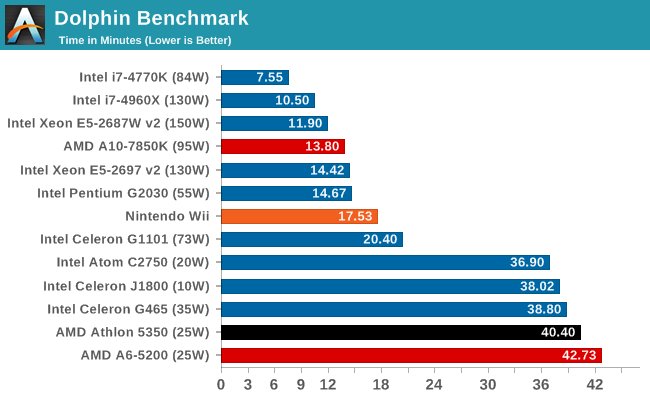
Point Calculations – 3D Movement Algorithm Test: link
3DPM is a self-penned benchmark, taking basic 3D movement algorithms used in Brownian Motion simulations and testing them for speed. High floating point performance, MHz and IPC wins in the single thread version, whereas the multithread version has to handle the threads and loves more cores.
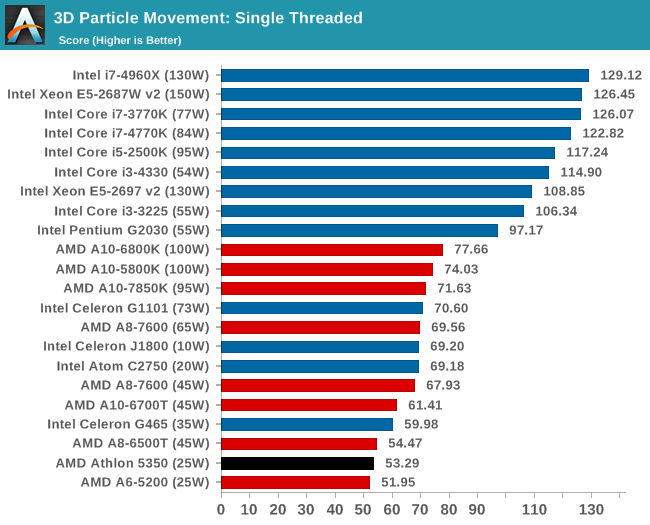
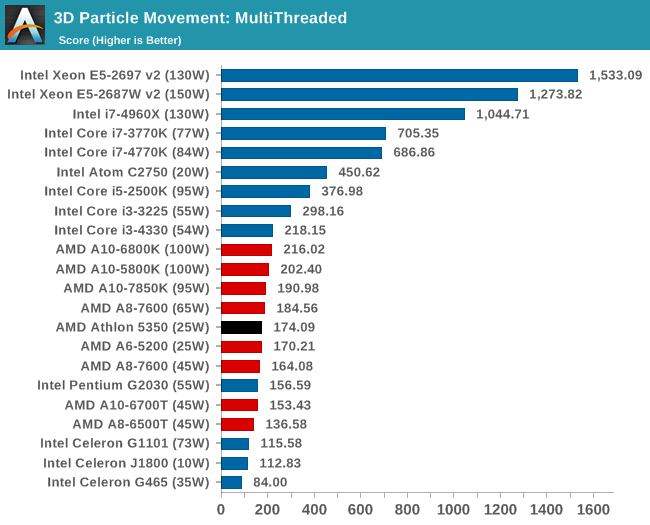
Encryption –TrueCrypt v0.7.1a: link
TrueCrypt is an off the shelf open source encryption tool for files and folders. For our test we run the benchmark mode using a 1GB buffer and take the mean result from AES encryption.
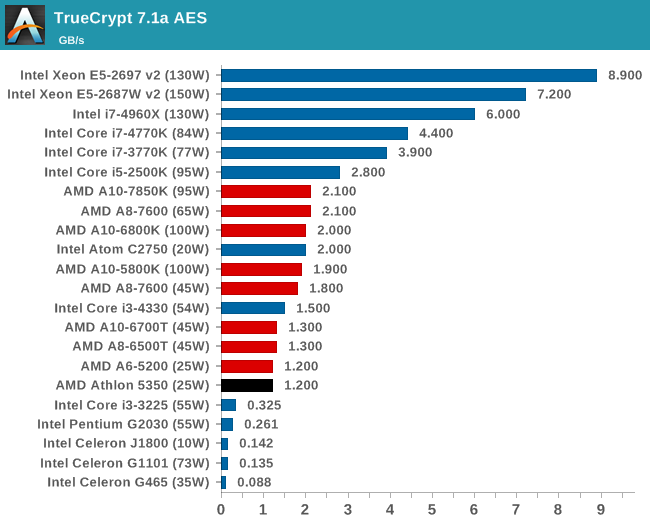
Synthetic – 7-Zip 9.2: link
As an open source compression tool, 7-Zip is a popular tool for making sets of files easier to handle and transfer. The software offers up its own benchmark, to which we report the result.
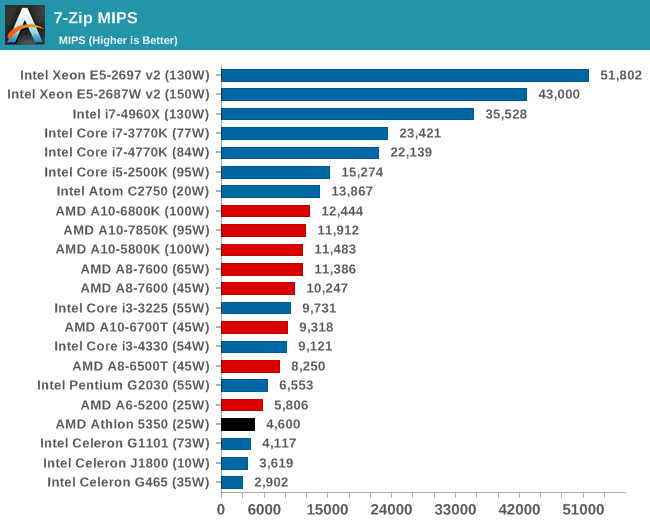
Rendering – PovRay 3.7: link
The Persistence of Vision RayTracer, or PovRay, is a freeware package for as the name suggests, ray tracing. It is a pure renderer, rather than modeling software, but the latest beta version contains a handy benchmark for stressing all processing threads on a platform. We have been using this test in motherboard reviews to test memory stability at various CPU speeds to good effect – if it passes the test, the IMC in the CPU is stable for a given CPU speed. As a CPU test, it runs for approximately 2-3 minutes on high end platforms.
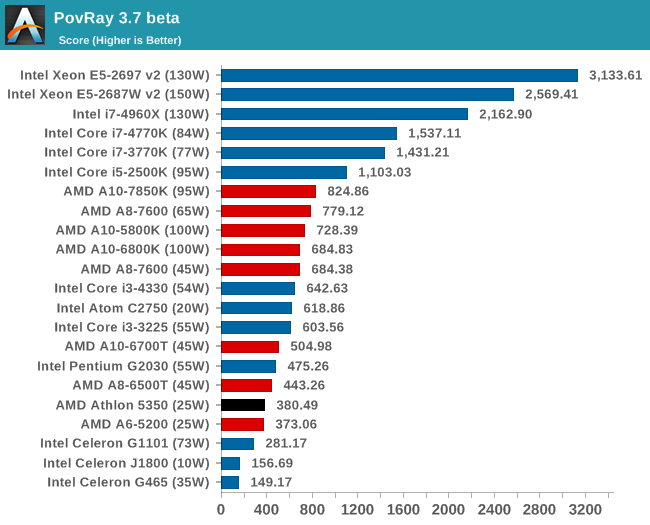










126 Comments
View All Comments
jabber - Wednesday, April 9, 2014 - link
Yep slap a 120GB SSD in there and you have a nice little office system for not a lot of outlay. Doesnt matter if its SATA2, its all in the access times.meacupla - Wednesday, April 9, 2014 - link
what would be nice is high bit rate software 1080p playback, for when DXVA doesn't work.I remember my E-350 getting choppy on those.
Medallish - Wednesday, April 9, 2014 - link
Well the one I built feels pretty responsive, even with a mechanical drive. You do need to install the drivers, but once they were on there it didn't feel at all sluggish, I tried loading up a bunch of heavily advertised pages on chrome, and didn't really notice any impact on performance. I must admit I haven't tried any 1080p Youtube videos, but I will give those a go, I imagine it runs fine, I had a Quad Core "Phenom II" Mobile CPU that ran 2GHz, performance should be pretty close to this I imagine. And yeah I did a test on that running a youtube video @ 1080p and a 1080p video on VLC at the same time, now this was running a 6670m which is bound to be a lot better than this, but the CPU wasn't holding it back atleast.gandergray - Wednesday, April 9, 2014 - link
Hello Ian. Thank you for the article. In the second to last sentence of the paragraph that follows the Athlon v. Celeron table in the “Competition” section, the word “subsiding” should be “subsidizing”.JDG1980 - Wednesday, April 9, 2014 - link
The Cinebench 10 benchmark indicates that Kabini's IPC is only slightly below that of Intel's old Conroe architecture (E2180, running at the same 2GHz clock speed). For such a small die and low TDP, that's actually pretty good. Integer IPC seems to be better than Intel's Baytrail series, though floating-point lags a bit (at least if 3D Particle Motion is a good test - never heard of it before).IPC for AMD's big cores is still not much better than Conroe, and lags behind Nehalem. Steamroller was supposed to help, but didn't do much for IPC (even though it did reduce the CMT penalty). This calls into question why AMD's 'construction equipment' cores are even still being developed. If the small 'cat' cores can do as well as they do with only a dual-issue front end, and a bunch of other missing optimizations (e.g. no decoded micro-op cache), then beefing up the basic design for desktop/server use would probably beat Steamroller in IPC while having lower power usage. It wouldn't close the gap with Intel's big cores, but it would at least provide a solid foundation to build on. This would be the same thing Intel did themselves back when they ditched the unviable Netburst design in favor of one derived from the mobile Pentium-M.
mrdude - Wednesday, April 9, 2014 - link
Yea, I think many people would agree with you. I like the Jaguar architecture quite a bit, as it seems to be very well balanced. The 4-way shared L2 and integer performance seem like very solid foundations to build upon. The fact that it has AVX whereas Intel's Atoms and low end Celerons don't is also an awesome feature....but it has no turbo. AMD's turbo core is actually really advanced, dynamically adjusting clock speeds and voltages depending on the CPU or GPU load or both. Even the steaming pile of poo that was Bulldozer had a great turbo, but for some reason AMD decided not to dedicate the resources and engineering talent to fit Kabini with the same feature.
I'd love to see AMD dump the construction line and work on something similar to Jaguar that scales upward and wider more easily. It might not be a monster, but at least it offers decent perf-per-watt.
errorr - Wednesday, April 9, 2014 - link
Pretty sure the 3d particle motion test was written by Ian and I vaguely recall it being related to his PhD Thesis.lever_age - Wednesday, April 9, 2014 - link
Just a small suggestion, but for comparative performance tables like the one on the last page, could you mark benchmarks by whether a higher or lower number is better (like on the larger graphs)? I guess this could be done either in the margin by the benchmark name or by coloring the winning column.mr_tawan - Wednesday, April 9, 2014 - link
Looks a lot like P3 or Athlon board to me, especially when the cpu+cooler is installed. Feel nostalgic.errorr - Wednesday, April 9, 2014 - link
Well except the lack of North Bridge and no diarrhea brown AGP slot.